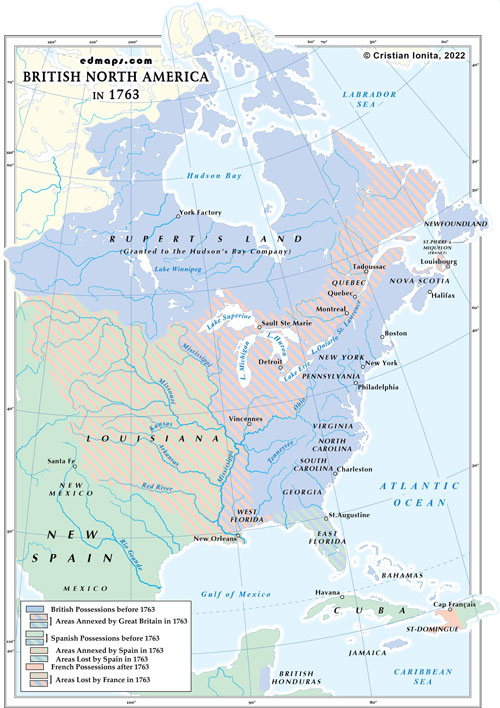British North America in 1763


British North America after the Treaty of Paris (1763)
After the Treaty of Paris in 1763, which ended the Seven Years' War (known as the French and Indian War in North America), British North America underwent significant changes. Here are some key developments and aspects of British North America after the Treaty of Paris:
Expansion of British Territory: As a result of the treaty, France ceded nearly all of its North American possessions to Britain. This included Canada (New France), the Great Lakes region, and the Ohio River Valley. Britain gained control over a vast territory, significantly expanding its North American holdings.
Proclamation of 1763: In an attempt to manage the newly acquired territories and prevent conflicts with Indigenous peoples, the British government issued the Proclamation of 1763. This proclamation established a boundary line along the Appalachian Mountains, prohibiting colonial settlement west of the line without explicit permission. The intention was to reserve the western lands for Indigenous nations and to regulate westward expansion.
British Colonial Administration: The British government implemented new administrative structures in the acquired territories. Quebec, which encompassed much of former New France, was divided into two provinces: Quebec and Montreal. These provinces were governed by British-appointed officials, with limited representation for French Canadians.
British Colonial Policies: The British introduced new policies and regulations in their North American colonies. They aimed to exert greater control over the colonies and extract revenue. Measures included stricter enforcement of trade laws, such as the Sugar Act (1764) and the Stamp Act (1765), which sparked resistance and protests among the colonists.
Settler Migration: The Treaty of Paris opened up vast lands for settlement in British North America. Thousands of British settlers migrated to the newly acquired territories, particularly to the St. Lawrence River valley, the Great Lakes region, and the Ohio River Valley. This migration contributed to the demographic and cultural transformation of the region.
Indigenous Relations: The British adopted different approaches to Indigenous peoples compared to the French. While French colonial policy often involved forming alliances with Indigenous nations, British policies varied. Some British officials sought to negotiate treaties and maintain peaceful relations, while others pursued land acquisition and settlement at the expense of Indigenous peoples, leading to conflicts and tensions.
Road to American Revolution: The changes and policies introduced by the British after 1763, including increased taxation and tighter control, played a significant role in fueling discontent among the American colonists. These tensions eventually culminated in the American Revolution, which began in 1775 as the colonies sought to gain independence from British rule.
The Treaty of Paris marked a turning point in the history of British North America, setting the stage for further developments and conflicts that ultimately led to the birth of the United States.








